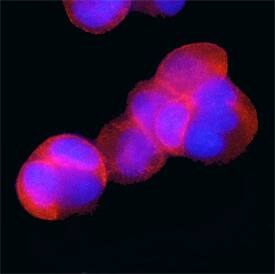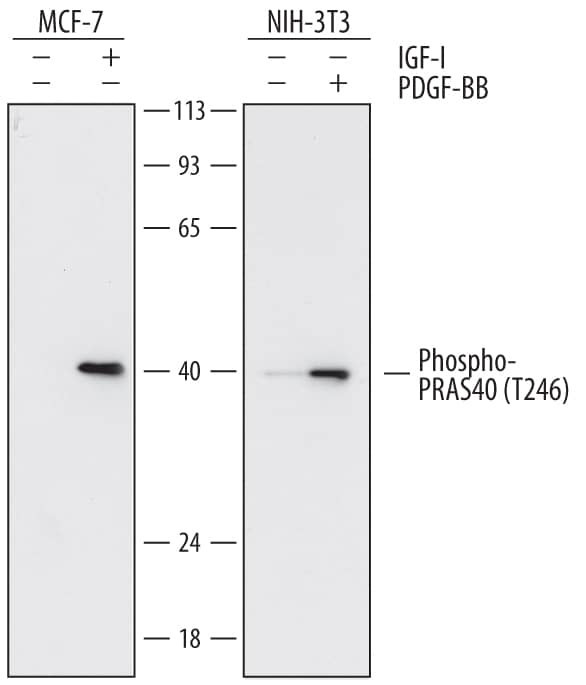Human/Mouse Phospho-PRAS40 (T246) Antibody
R&D Systems, part of Bio-Techne | Catalog # MAB6890

Key Product Details
Validated by
Species Reactivity
Validated:
Cited:
Applications
Validated:
Cited:
Label
Antibody Source
Product Specifications
Immunogen
Specificity
Clonality
Host
Isotype
Scientific Data Images for Human/Mouse Phospho-PRAS40 (T246) Antibody
Detection of Human and Mouse Phospho-PRAS40 (T246) by Western Blot.
Western blot shows lysates of MCF-7 human breast cancer cell line and NIH-3T3 mouse embryonic fibroblast cell line untreated (-) or treated (+) with 100 ng/mL Recombinant Human IGF-I (Catalog # 291-G1) for 20 minutes and 10 ng/mL Recombinant Human PDGF-BB (Catalog # 220-BB) for 5 minutes. PVDF membrane was probed with 0.5 µg/mL of Mouse Anti-Human Phospho-PRAS40 (T246) Monoclonal Antibody (Catalog # MAB6890) followed by HRP-conjugated Anti-Mouse IgG Secondary Antibody (Catalog # HAF018). A specific band was detected for Phospho-PRAS40 (T246) at approximately 40 kDa (as indicated). This experiment was conducted under reducing conditions and using Immunoblot Buffer Group 1.Phospho-PRAS40 (T246) in MCF‑7 Human Cell Line.
PRAS40 phosphorylated at T246 was detected in immersion fixed MCF-7 human breast cancer cell line using Mouse Anti-Human/Mouse Phospho-PRAS40 (T246) Monoclonal Antibody (Catalog # MAB6890) at 25 µg/mL for 3 hours at room temperature. Cells were stained using the NorthernLights™ 557-conjugated Anti-Mouse IgG Secondary Antibody (red; Catalog # NL007) and counterstained with DAPI (blue). Specific staining was localized to cytoplasm. View our protocol for Fluorescent ICC Staining of Cells on Coverslips.Detection of Human PRAS40 by Western Blot
PIK3R2 depletion, but not PI3K inhibitors, induces stable PI3K pathway inhibitionA. Tumor xenografts were obtained using H226, CaLu-1 and H520 lung SQCC cells expressing inducible PIK3R1 or PIK3R2 shRNA. When tumors reached ~50 mm3, mice were treated with doxycycline in drinking water (2 mg/ml); they were sacrificed when tumors began to diminish. Normalized tumor extracts were examined by WB with indicated antibodies. B. H226, CaLu-1 and H520 cells were cultured in exponential growth were incubated with: vehicle (DMSO, 1:103 V:V), Ly294002 (5 μM), PIK75 (200 nM), TGX221 (30 μM), or PIK75 (200 nM) plus TGX221 (30 μM) for the last 1 h of culture or during 48 h; extracts were tested in WB. Mr indicates relative mobility. In both A and B, the pAkt or pPRAS40 signal was measured and normalized to the loading control (Akt or tubulin, respectively), and compared to that in controls (DMSO, considered 100%). Graphs show percentage of signal compared to maximal as mean ± SD at 48h of treatment. Arrows on the right side of bars show the percentage of signal compared to maximal detected after 1h of treatment.* P <0.05; **P <0.01; unpaired Student's t test with Welch correction. Image collected and cropped by CiteAb from the following publication (https://www.oncotarget.com/lookup/doi/10.18632/oncotarget.13195), licensed under a CC-BY license. Not internally tested by R&D Systems.Applications for Human/Mouse Phospho-PRAS40 (T246) Antibody
Immunocytochemistry
Sample: Immersion fixed MCF‑7 human breast cancer cell line
Western Blot
Sample: MCF‑7 human breast cancer cell line and NIH‑3T3 mouse embryonic fibroblast cell line treated with Recombinant Human IGF‑I (Catalog # 291-G1) and Recombinant Human PDGF‑BB (Catalog # 220-BB)
Reviewed Applications
Read 1 review rated 5 using MAB6890 in the following applications:
Formulation, Preparation, and Storage
Purification
Reconstitution
Formulation
Shipping
Stability & Storage
- 12 months from date of receipt, -20 to -70 °C as supplied.
- 1 month, 2 to 8 °C under sterile conditions after reconstitution.
- 6 months, -20 to -70 °C under sterile conditions after reconstitution.
Background: PRAS40
PRAS40 (Proline-rich AKT1 substrate 1; also Akt1S1 and p39) is a 40-42 kDa cytoplasmic phosphoprotein that lacks generally recognized structural motifs. It is widely expressed and is considered to be key regulator of mTORC1 (mTOR plus raptor and G betaL), a complex through which Akt signals into the cell. Through phosphorylation, mTORC1 activity is upregulated by PRAS40. In particular, nonphosphorylated PRAS40 binds to and serves as a negative regulator of mTORC1 activity. Upon Insulin signaling, PRAS40 is phosphorylated on Thr246, Ser221 and Ser183. This causes it to bind 14-3-3 and results in its dissociation from mTORC1, freeing up mTOR to regulate (positively or negatively) protein synthesis. Human PRAS40 is 256 amino acids (aa) in length. It contains one extended Pro-rich region (aa 35-96) plus at least nine utilized Ser/Thr phosphorylation sites. There is one alternative start site at Met131. Over aa 119-256, human PRAS40 shares 93% aa identity with mouse PRAS40.
Long Name
Alternate Names
Gene Symbol
Additional PRAS40 Products
Product Documents for Human/Mouse Phospho-PRAS40 (T246) Antibody
Product Specific Notices for Human/Mouse Phospho-PRAS40 (T246) Antibody
For research use only


